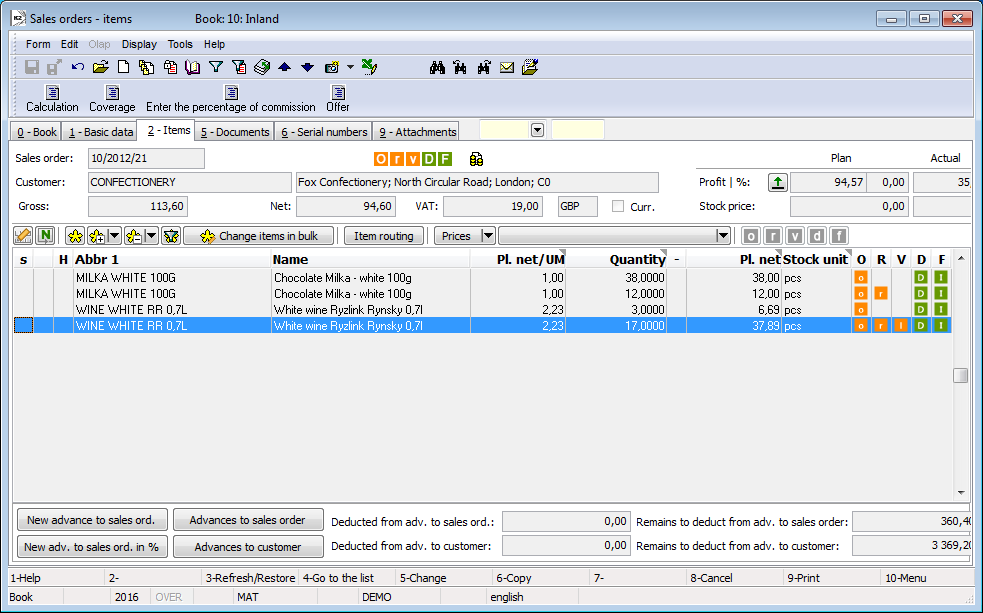Mutual Cohesion of Documents
The The Purchase Orders database is the support database of the Purchasemodule. Other documents are derived from this database - Invoices In, Delivery Confirmation and Receipt Cards.
The same principle is applied for the Sale module. In the Sale module, the support database is the Sales Orders database, from which the following documents are derived - Order Confirmations, Invoices Out, Delivery Note, Release Notes and Reserving Cards.
The so-called free documents (e.g. free Invoices In) that do not have a link with any support database and that serve only for the registering of the appropriate documents are the only exception.
Mutual cohesion of documents can be determined in the Purchase and Sale modules under flags, which are letters that contain data about the items of purchase and sale at the end of a row, or in the header on the first row of the 1st and 2nd page of the document.
The meaning of certain flags (letters) in the document header is different from similar flags at particular items on the second page of the document.
Cohesion flags are letters that provide information about the mutual cohesion of documents in the modules Purchase and Sale. This concerns the following letters:
D |
Delivery Confirmation |
I |
Invoice |
O |
Purchase Order |
P |
Receipt Card |
R |
Reserving Card |
The |
Release Note |
Note: You may encounter also other flags than just those described in this chapter. Overall, this concerns the flags that are related to Accounting as such and you can find their description in the chapter about Accounting.
In the document, the meaning of a flag depends on whether it is stated in the document header or at the end of the row along with an item of Purchase and Sale; it is also affected by being written in either lower case or upper case.
In the Purchase module, all processed items of articles must be inIn the order and in it, we use flags to determine which item and in what quantity is on the invoice, which on the delivery confirmation and which was received at the warehouse.
The same principle is applied to the Sale module - all of the documents are determined from the Sales Order.
The exception to this are the free documents, whose cohesion with other documents and flags cannot be tracked. Free documents are useful for instance for Release Notes - article release to consumption. No invoicing etc. is necessary here.
In the combination of colour and letter size, the following applies:
For the 0 page of superior document - header
- Orange / lower case - at least one item of a superior document is not on a subordinate document.
- Orange / upper case - all items of a superior document are on a subordinate document and not all of the subordinate documents are confirmed.
- Green / lower case - a superior document is confirmed and at least one item of the superior document is not on a subordinate document.
- Green / upper case - all items of a superior documents are on a confirmed subordinate document.

Picture: Reports book - 0 page
Note: Upon the flag evaluation, the setting of bans of Article Categories on particular subordinate documents is take note of, too. If there is even one uninvoiced item on e.g. a Sales Order that cannot be on an Invoice due to its Category, the flag I appears, i.e. a complete Invoice.
Flags are displayed in the document Sales Orders, as well as in Purchase Orders, and in the Book of Sales Orders, as well as in the Book of Purchase Orders.
Cancelled documents are marked with a special icon ![]() A cancelled document is colour coded in the list of documents.
A cancelled document is colour coded in the list of documents.
Flags in items of Purchase and Sale:
For the 2nd page of document - items
- Orange – a subordinate document is not confirmed, the letter is always lower case. If the double confirmation of Receipt Cards/Release Notes is checked, an orange 1 will appear in the case of first confirmation.
- Green – a subordinate document is confirmed, the letter is always upper case.
- Grey – a subordinate document is cancelled, the letter is always upper case.

Picture: Reports book - 2 page
A cancelled invoice remains in the database with the same data, only an icon ![]() of the cancellation has been assigned to it
of the cancellation has been assigned to it
To facilitate the process, the following overview provides information about creating documents on Invoices In from Purchase Order in the module Purchase.